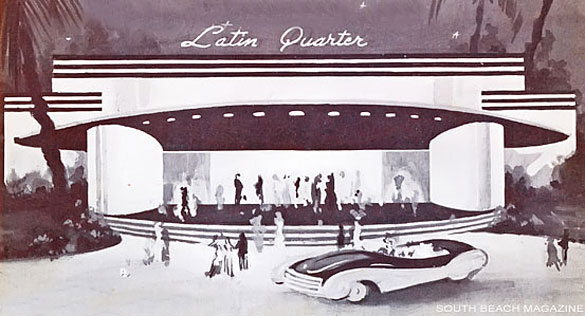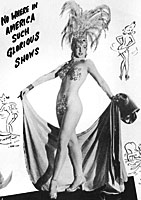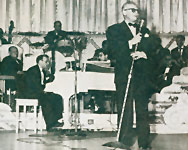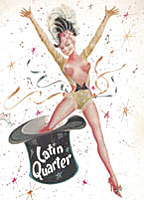
Driving across Biscayne Bay on the palm-lined MacArthur Causeway that runs between downtown Miami and South Beach, just past the cruise ships moored at the Port of Miami there is a bridge that leads over to the ritzy area of Palm Island. As the guard opens the gate and you proceed onto the island, the first thing you pass is a children’s playground full of swing sets, slides and see-saws. But half a century ago this location was an altogether different sort of playground, and it was definitely not for kids. From 1940 through the early ’60’s this was the location of the world famous Latin Quarter Nightclub.

Owned by Lou Walters, father of ABC 20/20’s Barbara Walters, the Latin Quarter was a mid-century Mecca for big-named entertainers who performed for winter crowds of tourists and celebrities arriving in Miami Beach each December. Entertainers like Frank Sinatra, Dean Martin & Jerry Lewis, Jack Benny and Tony Bennett all intermingled with waves of high-kicking chorus girls to perform three shows a night at the Latin Quarter.
Initially created in Boston in 1937, and later in New York City, Miami Beach’s version of the Latin Quarter opened in 1940 under the direction of Lou Walters and his partner E.M. Loew, the brilliant theatrical tycoon and owner of the vast Loew’s Theatres empire.
Modeled somewhat after the Moulin Rouge in Paris, the Latin Quarter prided itself in having the best and most beautiful dancers in the world. Tryouts were held all across America and Europe, at the Palladium in London and Club Lido in Paris, to find that certain handful of girls that “sparkled and shined.” They were billed as “Latin Quarter Dancers of Today, Hollywood Stars of Tomorrow.”

Costume ideas were submitted directly to Walters by the leading fashion designers of the day and manufactured by the Latin Quarter’s own full-time costume maintenance staff. Costumes were created for specific dancers to “enhance their best features,” as the club’s PR department proudly stated. The typical joke between Latin Quarter dancers as they took the stage in their semi-nude costumes went something like, “Gee, when I think of the money I wasted on singing lessons…”
The Latin Quarter’s success also spilled over to Las Vegas when Walters booked his Latin Quarter Revue into the Riviera Hotel in 1956, where he once put Zsa Zsa Gabor on stage in a $17,000 gown—big money in those days. Walters was also instrumental in bringing Les Folies Bergere to the Tropicana Hotel on New Year’s Eve, 1959. The show went on to become the longest running theatrical production in the world.

By the early 1960’s, the Miami Beach nightlife scene had migrated to Millionaire’s Row on upper Collins Avenue. Huge new oceanfront hotels produced dazzling floor shows and competed against each other for both the official title of Hotel of the Year, and the unofficial moniker of hottest spot on the strip. Nightspots like Eden Roc’s Mona Lisa Room and the Fontainebleau’s La Ronde Room booked the top bands, singers and comedians for the season and packed in the tourists year after year. So too, did Lou Walters. After the Latin Quarter, Walters moved his show to the Carillon, 1959’s Hotel of the Year, where his elaborate productions were considered the best on the beach for several years.
But, one by one the independent nightclubs closed their doors. Ciro’s, Copa City, the Beachcomber and even the dazzling Latin Quarter all passed into nightlife history. Some say it was the very same oceanfront hotels with their cut-throat competition for tourist’s dollars that finally killed off the independent clubs in Miami Beach during the 1960’s. Others say it was the evolution of jet-travel to distant and more exotic destinations that did them in. Who knows for sure. But the fact remains that, for a brief period fifty years ago, 159 Palm Island Drive was the hottest address in American nightlife.
